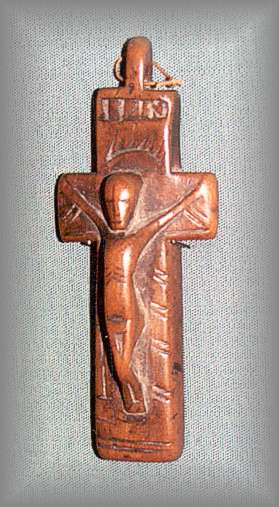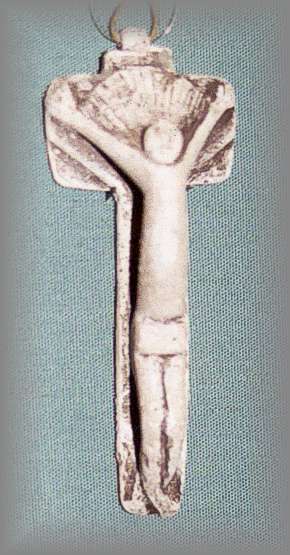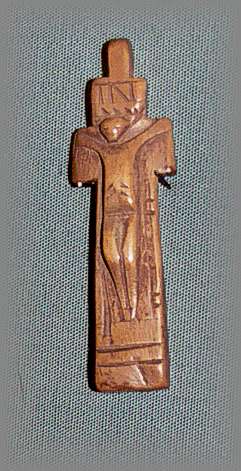| MUSEUM
Antique Rosaries |
HISTORY
of the Rosary |
for you index |
cord instructions |
LINKS |
EMAIL
US+
877 695 3561 |
![]()
![]()

Wood - 1799 - Ireland |

Lead - 1829 - Ireland |

Wood - 1799 - Ireland |
|
We are grateful to the Hunt for allowing us to share this information with you the students and lovers of the history of the rosary so you may learn more about the precious rosaries of Ireland. We have also added 2 rare Penal Crosses, one from 1722 and the other from 1729. With special thanks to Davoc Rynne of irelandcountryantiques.com for more informationalso
see
|
|
For hundreds of years people have used stones or beads to count their prayers. Beads for the Rosary of the Blessed Virgin are in use in Ireland since the Middle Ages and their introduction has been attributed to the Dominican Order. Rosary beads were made from a variety of natural materials, metals and glass. + Each decade of Aves ('Hail Mary') beads are separated by a Paternoster ('Our Father') bead and there is often a pendant of introductory prayer beads and a crucifix or cross. + Five-decade Rosary beads were the most common, although longer sets, decade rosaries and decade rings, were also known. There was great belief in the power of the beads to protect the home and its occupants from harm. |
|
CROSSES TO CRUCIFIXES The cross is perhaps the most widespread and ancient of all symbols. In early cultures, it was widely accepted that mankind was represented at the intersection of heaven on the vertical with earth on the horizontal. The Christian cross represents the significance of the crucifixion of Christ and in Ireland crucifixion scenes were often carved on plaques, stone slabs and metalwork. + Wooden crucifixes, popularly known as Penal Crosses are 18th and 19th century souvenirs of the pilgrimage to St Patrick's Purgatory in Lough Derg, Co. Donegal. They have short arms, not (as was once believed) for concealment during times of Catholic persecution but because they are carved from a solid piece of wood. [longer arms had a tendency to break off] + All of the crucifixes feature the Christ figure carved in relief and have various symbols of the Passion, the IHS monogram and the year of the pilgrimage incised. |
|
According to the history of Lough Derg, 'Penal Crosses have been found in many parts of Ireland. A study made in 1954 would indicate that they originated in the vicinity of Lough Derg, where they were made for selling to pilgrims visiting the holy site of St Patricks Purgatory. + One such cross was found in the hand of a victim of the only recorded boating tragedy on the lake in 1795. The cross was dated 1792, indicating that the lady had made the pilgrimage on at least one previous occasion.' + According to the National Museum of Ireland, these crosses were carved by local people and dated the year they were made. It is also believed the long narrow shape came from the fact that the arms would break off the cross easily. |
|
*THREE PENAL CROSSES* |
|
PILGRIMAGE SOUVENIRS 'Penal crosses are actually crucifixes that are thought to date back before the the time of the 17th century penal laws against the Roman Catholics in Ireland. These crosses often have symbols of the passion displayed around the corpus. It is likely that many of these penal crosses were produced as devotional souvenirs for pilgrims at Lough Derg. Co. Donegal. (St Patricks Purgatory, a holy site). Pilgrimages still take place to *Lough Derg every summer.' (The Hunt Museum with permission) +
LEAD PENAL CROSS - 1829 H 9.7 x W 3.9 x D 2.4 'This rare example is one of only 4 lead penal crosses recorded. It possesses some of the defining features of the wooden crosses, such as the short arms, the figure of Christ in high relief on the obverse and the sacred inscription "IHS" on the reverse. However, it lacks the usual abundance of Passion symbols. There are some schematic parallel lines on both sides of the lower shaft, which are similar to the degraded representations of the ladder on some of the later wooden crosses. + Generally the earlier crosses were carved in a more naturalistic fashion that this one, and with finer detail. Although this example has a well defined fan-shaped halo and the elongated figure of Christ in high relief, the hands and face and crossed feet are ill defined and more representative of the degeneration of the later examples. This suggests that the faint incised date on the reverse face, which seems to read '1829' is probably the correct date of the cross.' (p 132 - The Hunt Museum Essential Guide) + CATHOLIC EMANCIPATION 'Your lead one (above) is interesting because it is late 1829 - Catholic Emancipation was introduced that year.' Davoc Rynne of irelandcountryantiques.com |
|
*VARIATIONS ON A THEME* |
|
We are used to seeing certain combinations on these chaplets and rosaries, especially if commercial adaptations but here are two perfect examples of the freedom or availability of use. +
CRUCIFIX 'UPSIDEDOWN' In Ireland the Paidren Beag, meaning 'small prayer' was a smaller rosary with ten beads and a crucifix at one end and a ring at the other. The ring was passed from one finger to the next to keep count of the prayers. Another version was the rosary ring which had 10 projections and a cruciform bezel for the Paternoster. (Hunt Museum) + As a Penal rosary or chaplet, this one has a Galway crucifix on one end and the traditional 'Thumb Ring' on the other, (Dated 18c). We normally see the Penal cross, not the Galway cross. +
STRUNG 5 DECADE The rosary above is a standard 5 decade bone Rosary and has a hand carved wooden Penal Cross at one end and a small cross at the other. (not dated). |
|
OF CROSSES ABOVE +
UNIQUELY DIFFERENT Close-ups of the Galway and Penal Cross on the Rosary and Chaplet above. (Taken at an angle, crossbars are not bent!) |
|
*ROSARY DIRECTORY* |
|
An overview of the rosary crosses of Ireland |
|
Unique tubular crucifixes in silver, influenced by the Spanish trade from the Hunt. |
|
18c Penal Rosaries and crosses, a mini history with pictures. |
|
Rosaries of amber and ivory, from the 1700s - 1800s |
|
HUNT MUSEUM then to collections (left side) then to BROWSE Scroll down to R (religious) and enter + or write THE HUNT MUSEUM The Custom House Rutland Street, Limerick Ireland Tel 061 452022 |
|
*PENAL CROSS 1729* |
|
Museums in Ireland date penal crosses from about 1695 until 1823, when Ireland was beginning to emerge from the Penal Laws and Times. This Penal cross predates the ones shown above. +
Cast in solid bronze in 1915 - inspired from the original to be given as a souvenir to attending guests. Original may have been carved from wood. 1.75" X 00.65" Images shared by Davoc Rynne (irelandcountryantiques.com) |
|
*PENAL CROSS 1722* |
|
We missed bidding on the wonderful cross above dated 1729 and were very disapointed! We hoped and prayed nother would be offered and it was, we cauught it and had it cast. It is available now in our Supplies catalog. + A VERY RARE FIND
SHOPPING
A rare find! Almost identical to the one above dated 1729. So close in design, one has to wonder if they were originally carved and cast by the same artist. Found on Ebay and identified by the seller as a chaplet from the 'Spanish Colonial Period.' (Very possible as trade between Ireland and Spain was common during the Penal Times but we believe more recent. + FROM MARY VARILY Mary lives in Ireland and uses these old crucifixes in her work. She shared: "By the way, I tracked down the Belfast supplier who makes the Penal crosses for the Knights of Columbanus, I think his grandfather made the original ones when the Knights were set up in Belfast in 1915 ... + ... And at Showcase a lady who had worked with Enterprise Ireland told me she assisted the jeweller who did the designing of [this] cross which she said was created for some commerative purpose in the late Sixties" + She added she hopes to find out more in time. Thanks Mary, this is very helpful info for those who are searching for the history of these little Penal Crucifixes. RW |
|
*MORE INTERESTING FACTS* |
|
OBVERSE: Figure in relief with nimbus around the head. Hand engraved symbols of hammer, pincers, cords, ladder and spear incised around the figure. Across the top shaft "INRI". At bottom of shaft below feet of cock over a pot, and two scourges. REVERSE: "IHS" across transom with cross rising into upper shaft from bar of "H". Below "H" three nails in fan formation. A long shaft below nails the date "1729". + HISTORICAL NOTES FROM DAVOC RYNNE "In all our years of dealing, we have only once seen one similar to this in the National Museum of Ireland. These apparently were issued to The Knights of Columbanus to initiate new members to the Order - during the foundation years - Belfast 1915. |
|
The agreed terms of the Treaty of Limerick were quickly contravened. In 1678, Lord Lieutenant Ormond barred Catholics from entering Dublin Castle without his expressed permission. Every session of the Irish Parliament, from 1695 to 1746, brought into law draconian measures against Catholics and assigned them a subservient position in Irish society. Their aim was to exclude 'Papists' from political life, dispossess them of their remaining lands and to encourage conversions. + The Banishment Act of 1697 exiled all Catholic Bishops, registered resident Priests and forbade their replacement 'under pain of death'. Rewards of £30 were offered to Priests to convert and £5 paid per capita to 'Priest Catchers'. Inherited Catholic land had to be divided among all sons - unless one converted and so obtained the entire holding. Due to the 1704 Popery Act, Catholics could not purchase land - only rent it for less than 31 years. + This 1704 Act, by barring all non-Anglicans from political and government offices, also discriminated against Presbyterians, Quakers and other 'dissenters'. They were treated less severely than Catholics, in that their land holdings were unaffected. However they resented the policy of discrimination and the fact that they had to pay tithes to support the Anglican clergy. Many thousands emigrated to the American colonies. + Lord Lieutenant Harcourt (1772 - 1777) wrote that "the Presbyterians in the North are in their hearts American". Eleven Presidents of the United States were descendants of Ulster Protestant emigrants (as were Davy Crockett and Elvis Presley). + In 1726 the Lord Chancellor, Richard West, declared that: "The law does not suppose any such person to exist as an Irish Roman Catholic". The right to vote was removed from Catholics by act of Parliament in 1727. Other Penal Laws included the closure of Catholic schools (which forced education of Catholics underground) and the barring of Catholics from entering a profession, the army, or attending Catholic worship - however they were required to attend Anglican service. + The Dubliner and Member of Parliament, Edmund Burke, whose statue stands in the front lawn outside Trinity College, summed up the Penal Laws as "a machine of wise and elaborate contrivance, as well fitted for the oppression, impoverishment and degradation of a people and the debasement in them of human nature itself, as ever proceeded from the perverted ingenuity of man". |
|
During this period schools were closed and many churches and abbeys were destroyed throughout Ireland. Priest-hunting was the order of the day but the people kept there faith. Crucifixes began to be made in secret. Mainly carved in wood, they were from six to ten inches long and the narrow cross-arm enabled them to be hidden up the sleeve of a jacket for easy concealment. + Known examples of these crosses with dates ranging from 1695 to 1823, are to be found in Irish museums. After 1823 Ireland was slowly emerging from Penal restrictions. + Penal crosses are crudely made wooden crucifixes with the symbols of the Passion together with the cock-and-pot motif. This motif is very common and appears on nearly every member of the group. The cross arms are remarkably short in every case. + The late Tomas Cardinal O Fiaich chose a penal cross for his pectoral cross." with very special thanks
to
|
|
MISSION STATEMENT Our vision is to provide the finest handmade rosaries, chaplets and other fine religious art forms for personal worship we can make using the finest supplies available. The Guild believes the work of our hands should give visual Glory to God, therefore for us, the best for you is very, very important. +++ QUESTIONS? ASK US: copy and paste beadsong@hotmail.com OR CALL WEEKDAYS - 9 to 5central 877.695.3561
MUSEUM
- HISTORY
- PRAYER
for more information see
OFFICE
HOURS
|
|
secure-online - credit card -[or]- mail in - mo/personal check |